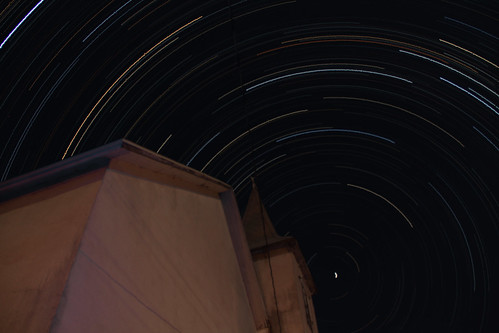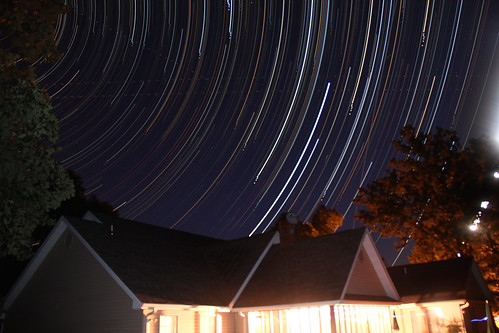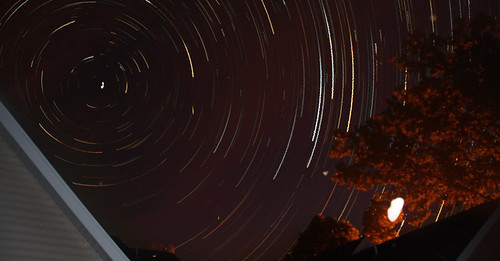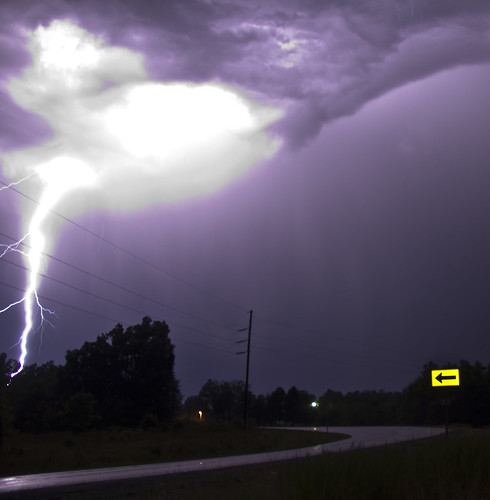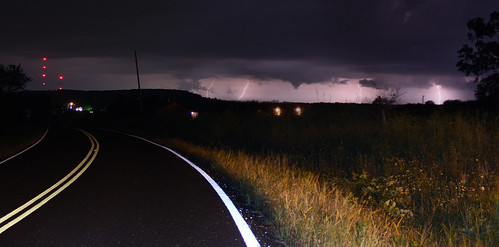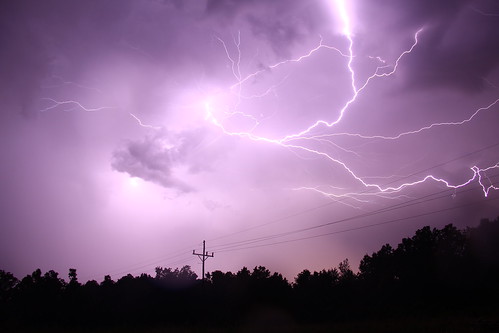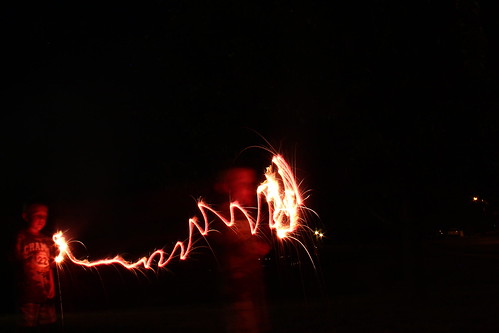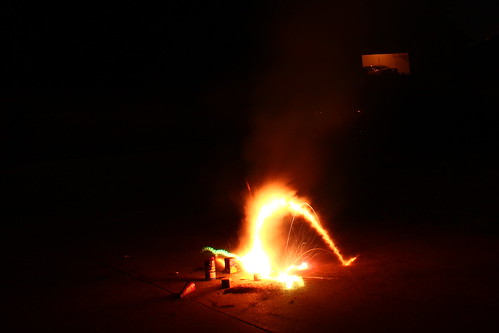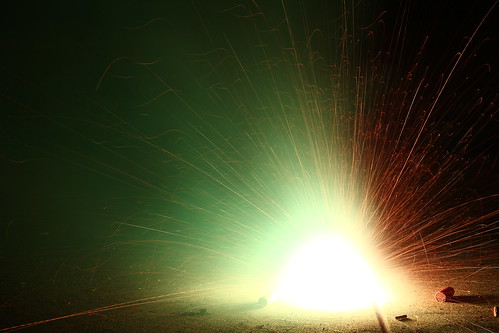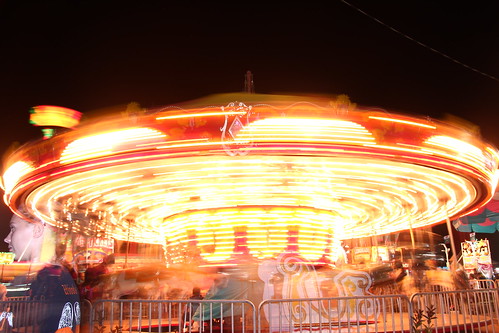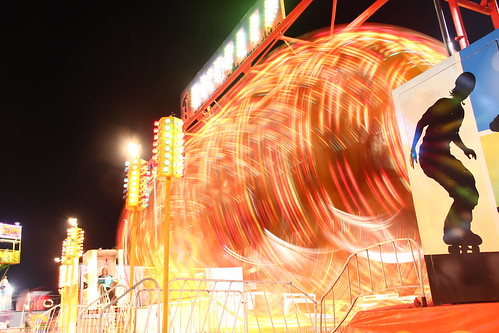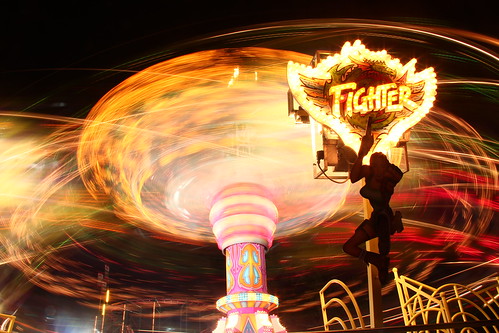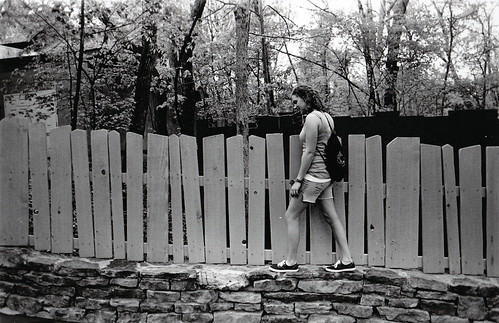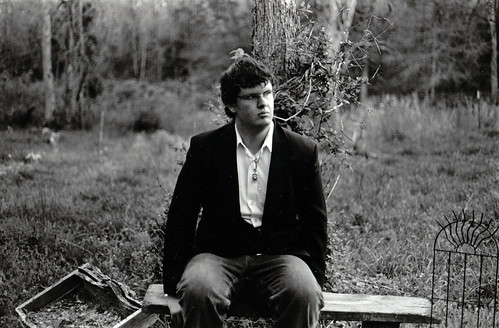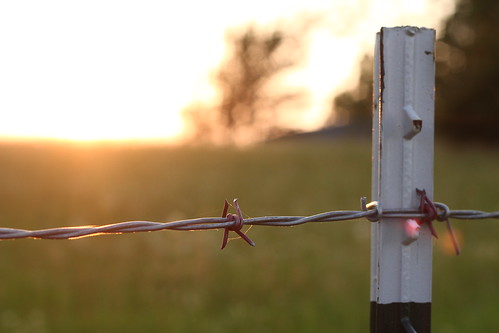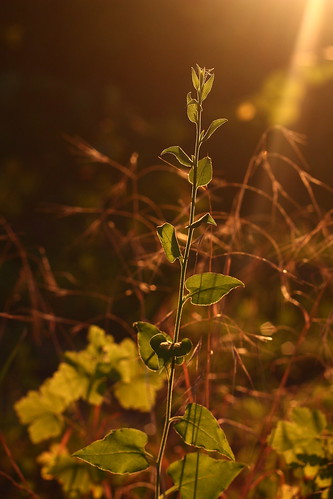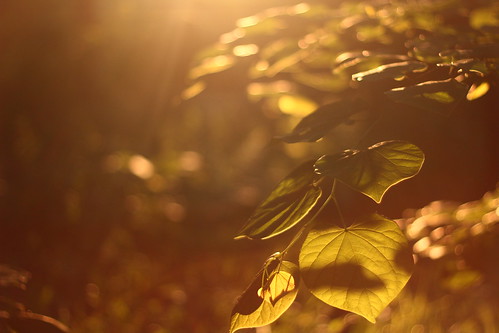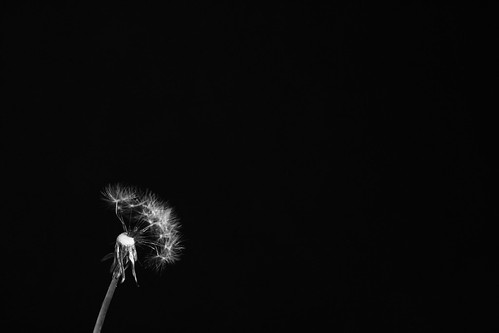follow me on the twits yo!
check out the twits
Sunday, November 20, 2011
Electroacoustic Interpretation of "Non-Commercial Music"
This is a piece I recently recorded for my Electronic Music class. Our assignment was to manipulate recorded audio and compose a piece that was "non-commercial". Not knowing entirely what that meant, I strived to stray away from most conventional musical properties. I apologize in advance for any melody, timing, beat, rhythm, etc. that you may hear in this piece. I tried my hardest not to include it.
Thursday, November 17, 2011
Warming The Seats
Warming The Seats from Josh Campbell on Vimeo.
This was my first attempt at cutting together video footage and recreating a narrative. The story was inspired by a dream I had...
Wednesday, November 16, 2011
End of the World: Track 1
Tuesday, November 15, 2011
Remembering September 11
Monday, November 14, 2011
Even Though...
Saturday, November 12, 2011
Macro Extension Tube
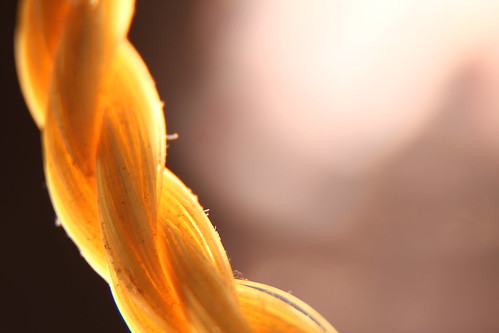
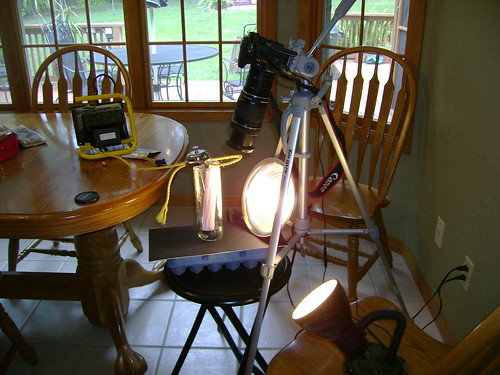
As you can see from the photo above, the grass was still green with I shot these photos. It wasn't until this fall that I learned that f-stops are constant only in exposure and not it terms of depth of field. What I mean is this: if you meter a scene and it reads an exposure of 1/30s at f/5.6, no matter what camera or what lens you use, your exposure will be the same. But depth of field at f/5.6 might not be same from lens to lens. The reason that cheap zoom lenses have a variable maximum aperture, like f/3.5-5.6, is because the meter has to compensate for the changing distance between the lens and the sensor or negative. As you zoom further out, the distance becomes greater and less light can reach its destination. So, when your zoom lens is fully extended and you're shooting at f/5.6 instead of f/3.5, your aperture is not closing down, indeed it is actually the same. It is merely compensating for the difference in light. Your depth of field will remain the same.

You can check out the rest of the macro tube photos here.
Thursday, November 10, 2011
Macro Extension Tube


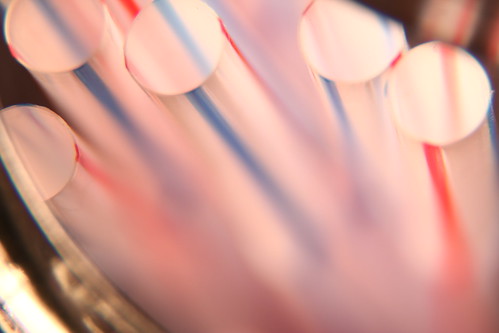

Wednesday, November 9, 2011
Stop Motion and Time Lapse: The Beginnings
Tuesday, November 8, 2011
Downtown Springfield: A Time Lapse
Monday, November 7, 2011
Downtown Springfield: A Time Lapse
Saturday, November 5, 2011
Star Trail 10/24/11
I didn't catch the Northern Lights in this particular image, but it was a strange sight to see. I shot this star trail on a whim early last week. It turned out well and yielded one of the best time lapses I've attempted yet.
Instead of using the Star Trails application, I used an action for Photoshop. Star Trails is a windows only program. Also, the software hasn't been updated in years and I'm worried it might become obsolete. For the time lapse, I imported the images to Premiere and set the length of each still to 1 frame (instead of the default 150) in a video set to 30 frames per second. So, every still being a 30 second exposure, each second in the time lapse is actually 15 minutes in real time
Thursday, November 3, 2011
Pleasant View Church: Part II

I set up my camera across the road from the building and this is the first image that it yielded. You can't see the church!

I removed all the traffic trails from the composite. But there were several really nice traffic trails...
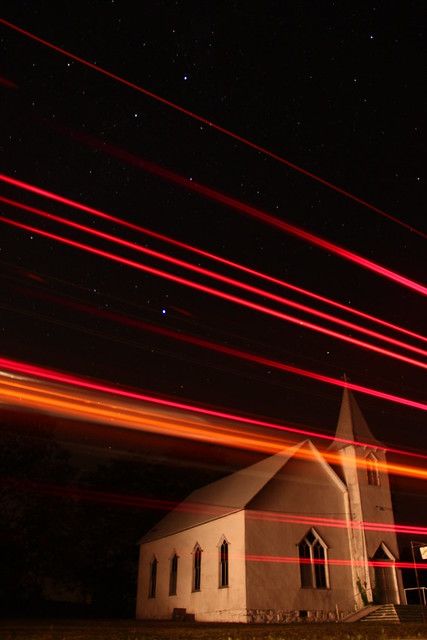
...like this one.
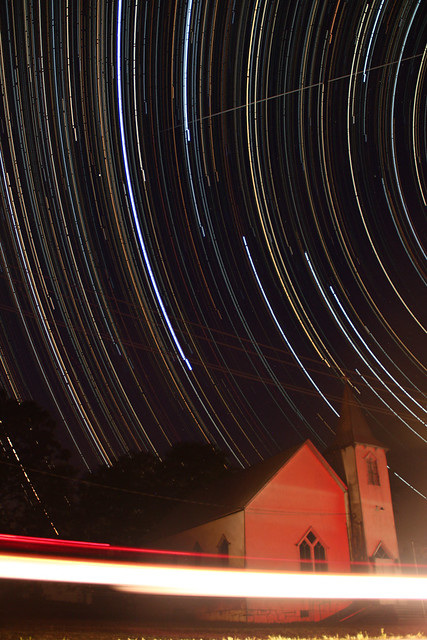
Ultimately I think I've settled on this image. It includes the traffic trail which activates the bottom of the picture, you can make out the details of the building, and the star trail takes center stage in the top.
This is my favorite, but I'd like to hear your opinion on which image is strongest!
Wednesday, November 2, 2011
Pleasant View Church
This image turned out a little dark, my camera's LCD screen fooled me. It looked a lot brighter in the comparative darkness of my surroundings. I suggesting shooting 30 second intervals between ISO 400 and 640 at your widest aperture.
Tuesday, November 1, 2011
Star Trail 7/26/11
Monday, October 31, 2011
Star Trail 7/7/11
This is a composite image from 402 images. Each exposure was 30s at f/3.5 at ISO 400. The flash popped at the beginning of each exposure 1/8 power. Stitched together using StarTrails and minor edits in Photoshop.
The video below tracks the motion of the stars through the course of the night.
Wednesday, October 26, 2011
Lightnin'
13s at f/4.5 ISO 100
Tuesday, October 25, 2011
Lightnin'
Composite image from 6 different exposures. Camera set to continual shooting mode, 10s at f/4.5 ISO 640. Flash set to second curtain. The foreground and background contrast well, both in value and color, the orange in the foreground with the purple in the back, though a certain warmth binds them together well. Use of flash creates an interesting subject for the photo, but the hero is the background. The four bolts of lightning, the power post, the radio towers and trees on left and right provide a nice repetition. Cropping also adds interest, as the dimensions of the image are atypical.
10s at f/4.5 ISO 640
Monday, October 24, 2011
Lightnin'
13s at f/4.5 ISO 100
Thursday, October 20, 2011
Chocolate Chapstick (DS Remix)
I am currently enrolled in Electronic Music, a class required for my minor. Since I arranged this song, I've learned a couple or a few things about synthesizers, knowledge which would have been helpful when I created this piece.
Using the Korg DS-10 to produce the music, I manipulated only the carrier signal (the initial input note) of each synthesized sound. I adjusted the envelop (how the sound opens and closes), the shape of the wave (sine, sawtooth, etc.), and the amount of distortion (by cutting or boosting gain). I also manipulated EQ by using high and low pass filters.
By controlling these few elements I've ended up with some relatively interesting sounds. However, this instrument seems to be capable of a level of complexity I haven't demonstrated in this piece--there's a lot more to learn.
Hope you enjoy! Here's the original to compare.
Wednesday, October 19, 2011
A Stranger No More To Be (DS Remix)
I received the Korg DS-10, a synthesizer built by Korg for the Nintendo DS, as a Christmas gift a few years ago. Though I requested it, I never took the time to pick it up and figure out how to use it. I had never written music on a synthesizer and didn't know where to start. Eventually, it struck me that I could figure out the process best by arranging an existing composition.
You can listen to the original here.
Tuesday, October 18, 2011
Panoramic Narrative
1.3s at f/5.6 ISO 200
check it on flickr
Monday, October 17, 2011
Panoramic Narrative
Next time, I would overlap my images more during production. It was difficult only having a small area of overlap to blend the images with. Moreover, I noticed some vignetting happening near the edges of the frames, only adding to the difficulty of blending. Look closely and you will notice some of the problem areas.
1.3s at f/5.6 ISO 100
Sunday, October 16, 2011
Saturday, October 15, 2011
Bottle Rocket Wars
Most of these photos were shot as soon as the sun set, giving us the minimum amount of darkness to start the show. There was still some ambient light hangin' around and I found my best apertures to be between f/16 and f/20. I could have went smaller in the longer exposures--some of the detail in the middle parts of the fireworks are blown out.
17s at f/18 ISO 100
Wednesday, October 12, 2011
Bottle Rocket Wars
We'd spend the day light hours shooting off all the wimpy stuff, but when night fell, we'd pull out the big guns. Fourth of July has changed over the years. The big finale has transformed from terrifying event that overwhelmed my untrained senses, to a theatrical display I participated in as a spectator, to a performance in which I played a lead part, and now, again, something I merely enjoy and observe from the sidelines. As I get older, the world has gotten smaller in some ways, some things have lost their wonder, their grip on me. While I may not be amazed by a simple light show these days, it still brings that sense of nostalgia and days long gone.
6s at f/20 ISO 100
Tuesday, October 11, 2011
Bottle Rocket Wars
Once I threatened my brother at bottle rocket-point, lighter poised to ignite. He wouldn't leave my room and left me no other choice. It was meant to be merely a facade. By accident, I stepped too close to the edge and lit the rocket. I had no other choice than to allow the rocket to spray its sparks and explode in my hand.
For those who don't know, the stem on the bottle rocket guides it straight, take it off and you've got yourself a free agent. It was bottle rocket Russian roulette. We'd play games of chicken by lighting these stemless bottle rockets and throwing them between us—you were marked a coward if you fled.
19s at f/18 ISO 100
Monday, October 10, 2011
Bottle Rocket Wars
There was probably a more economical way to set fire to G.I. Joes and Barbie dolls, but we rather enjoyed our weapon of choice. It was a tier process—first you'd start with snakes and poppers. Once you got a little older you advanced to sparklers and smoke bombs, neither of which, I might add, are particularly safe. Smoke bombs spew fire before emitting smoke and sparklers are just pointed fire sticks. Both were vital in starting a good fire.
The next graduation was to bottle rockets and firecrackers.
We were told to lay on the ground anything we set off, to allow us tim to flee and to keep the explosion out of our hands and away from our faces. So smoke bombs and firecrackers should lay flat and bottle rockets in bottles. I don't know if these restrictions are naturally boring or if we simply got terrible ideas from the older kids. Rarely were firecrackers on the ground when lit or bottle rockets in their bottles.
8s at f/18 ISO 100
Saturday, October 8, 2011
Dinner With A Gypsy: Ozark Empire Fair 2011
You can check the rest of the photos here!
1/3s at f/4.5 ISO 100
Thursday, October 6, 2011
Dinner With A Gypsy: Ozark Empire Fair 2011
I parked cars this summer at the Ozark Empire Fair. Incredibly easy gig—worth an extra couple hundred bucks and the opportunity to meet some new and interesting folk. Plus, you can satisfy all your fair needs for free! My goal was to shoot the carnival every night I was there, but I was not feeling well that week and didn't have the energy.
1s at f/8.0 ISO 100
Wednesday, October 5, 2011
Dinner With A Gypsy: Ozark Empire Fair 2011
I'm told the cars, which are parked nearest to the carnie lodgings, are kept under tighter security than other lots. They say the carnies will keep an eye on who gets out of what car and what valuables are left there. In fact, there are those who travel with the carnies who do not work the carnival, but simply make their living by pickpocketing fair-goers and thieving from their vehicles.
I find my shot in front of a ride. I'm running low on time and energy and set up my gear quickly. I want to catch the ride in action on its next rotation so I can move on. The ride seems to be having technical errors. One operator is working on the issues, while the other two stare blankly at the mounting crowd before them. They speak, condescendingly, in some foreign tongue. It doesn't take more than a few minutes for the ride to return to “online” status. The two load the riders sloppily and slam their safety latches. Clearly, they're irritated there are riders there at all.
The ride goes 'round and I get my shot—but I wonder: Who hated who first? The carnies or everyone else?
4s at f/7.1 ISO 100
Tuesday, October 4, 2011
Dinner With A Gypsy: Ozark Empire Fair 2011
“Some customer service,” I think, “At least she put out her cigarette.”
They travel around in packs, caries do, like American gypsies. They scrape together a living by throwing together shoddy carnival rides and ripping off parents with cheap, but alluring prizes to expensive, but impossible games. When the fair rolls into town, an entire lot fills with their rundown recreation vehicles and campers, a resembling Hoover towns from days long past.
I keep going down the midway, the “Champs Elysees” of the carnival, and pass through a cloud of cigarette smoke from a ride operator. In the same breath he exhales his addiction and let's loose a series of curse words, behaviors far from a professional nature.
1s at f/5.6 ISO 100
Monday, October 3, 2011
Dinner With A Gypsy: Ozark Empire Fair 2011
The photos are the first set in a series of night photos that I'll be showcasing over the course of next following weeks. Enjoy these images from the Ozark Empire Fair!
3.2s at f/22 ISO 100
Saturday, October 1, 2011
Photo 1 Portfolio--Kara
You can check out the rest of my portfolio here!
Thursday, September 29, 2011
Wednesday, September 28, 2011
Tuesday, September 27, 2011
Monday, September 26, 2011
Photo 1 Portfolio--Ty
Perhaps my instructor thought my subject matter, people, to be a bit blasé, a lot of students in the class chose to use people as their theme, and there is no doubt that numerous students in classes past have photographed people as their theme. I had a lot of work to do to distinguish myself from those who have set the precedent. My instructor thought that I would choose to present texture shots and photos of strange objects, abstractions of sorts. But I've shot those photos too many times to count. It is no longer a challenge to capture an interesting image of an abstract texture or object. I wanted to shoot people to gain experience in that subject matter. And despite receiving an unsatisfactory grade in that class, I learned more about portrait shooting than I have anywhere else, an invaluable lesson.
So there you have it kids—the classes you learn the most in are the ones you also get the worst grade in. School sucks.
Thursday, September 22, 2011
Big Rock Candy Mountain
In anticipation of the weekend, I've conjured up some original audio-magic. Enjoy MarvinBaker87's rendition of Harry McClintock's Big Rock Candy Mountain!
If you're not overly offended or disgusted, you can check out some other tunes at Bandcamp.
Wednesday, September 21, 2011
On a Walk Around the House
And most of my first shoots were from long walks I would take in and around the hometown. These photos are in the same vain, shots from a long walk around the house.
1/400s at f/5.0 ISO 400
Follow this link to view the rest of the photos.
Tuesday, September 20, 2011
On a Walk Around the House
After receiving the grade for the class, I emailed my teacher to get some feedback on my work. He told me the grade was based mostly on my final portfolio and he suggested shooting more photos to improve.
So I did just that.
1/320 at f/5.6 ISO 400
Monday, September 19, 2011
On a Walk Around the House
1/640s at f/5.6 ISO 400
Sunday, September 18, 2011
On a Walk Around the House
Big day tomorrow. Big days usually throw my sleep schedule off. It's summer and I've been staying up late and sleeping in. Hard to adjust to normal-people-sleep. Tack jet lag onto that, you got yourself a sleep catastrophe. I won't be able to sleep tonight. Too much pressure to get a good night's sleep. I'm leaving f or Uganda tomorrow. Gonna be a long day. Been before, doesn't seem real 'til you're about to leave. And then you can't sleep. It's 7 o' clock. I probably woke up at 11. Can't remember, busy day, been packing. Uganda in a few short hours. I wish I felt more prepared. Does anyone feel prepared? Can you? I think it's best to be prepared for the unexpected. Is that the same as being unprepared? I hope I didn't forget to pack anything. Shouldn't have waited 'til the day before. I'm not gonna be able to sleep. Need to expend some energy. Maybe I'll take a walk to clear my head...
1/1600s at f/1.8 ISO 400
Saturday, September 17, 2011
Not Forgotten: Journalism and Self Expression in Uganda
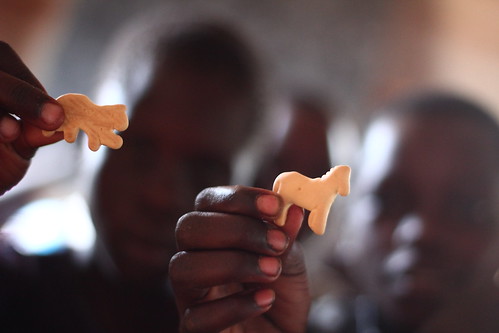
Not Forgotten: Journalism and Self Expression in Uganda, a photo by TheLouisianaJackhammer on Flickr.
1/160s at f/1.8 ISO 1600
You can go here to view the rest of my Uganda photos.
Also, extra special video footage...
...from the children of Lingira...
...and a sample of the Ugandan Worship experience.
Thursday, September 15, 2011
Not Forgotten: Journalism and Self Expression in Uganda

Not Forgotten: Journalism and Self Expression in Uganda, a photo by TheLouisianaJackhammer on Flickr.
But something as simple as the resources to complete a self portrait can really bring a sense of vitality to a person's life. These children were thrilled just to see the image of their own faces—a simple, but obvious, individual distinction. It was a simple exercise, cheap, not overly profound. You may wonder if it really mattered, if it really had an effect. It does—this small form of self expression is a way to encourage a beautiful people and to let them know they have not been forgotten.
1/40s at f/2.8 ISO 1600
Wednesday, September 14, 2011
Not Forgotten: Journalism and Self Expression in Uganda

Not Forgotten: Journalism and Self Expression in Uganda, a photo by TheLouisianaJackhammer on Flickr.
It is important for people to express themselves. Perhaps we've forgotten this in the west, we have so many opportunities and avenues to express ourselves, we can hardly imagine a place where you wouldn't be able to. In fact, its so easy to express ourselves, maybe we don't even realize we're doing it! In America, we have so many choices to define who we are—what am I going to wear, how will I cut my hair, what will I study in school, what will my hobbies be. We have jobs that don't exist in other parts of the world. Children have many opportunities growing up in school as well—so many, in fact, that few would be grateful for just a crayon and a piece of paper. The combination of these factors makes us individuals, for better or for worse. We are each set apart from everyone else, and our choices are an outlet for that distinction. When you don't have options it becomes increasingly harder to distinguish yourself. When you can't choose what to wear, or you have few options for school or career, of if you spend most of your time fighting to survive, you become lost in the population. You become just another cog in the machine and you don't really care if you live or die.
1/400s at f/3.5 ISO 100
Tuesday, September 13, 2011
Remembering September 11
I'll talk more about it later on...
Enjoy for now, compatriots!
Not Forgotten: Journalism and Self Expression in Uganda

Not Forgotten: Journalism and Self Expression in Uganda, a photo by TheLouisianaJackhammer on Flickr.
Photography changed the way the news business worked, bringing back images from wars and riots—things that might people might not have believed if they hadn't seen it with their own two eyes. And not all news is bad news. Uganda is an encouraging place. Despite the extreme poverty in this third world country in East Africa, the Ugandans are joyous and grateful people. As Americans, we may look at their lives and wonder what they have to be thankful for, but to the Christ followers of Uganda it is very obvious. God loves them and has provided for them what little they have to make it through the day.
1/25s at f/4.0 ISO 1600
Monday, September 12, 2011
Not Forgotten: Journalism and Self Expression in Uganda
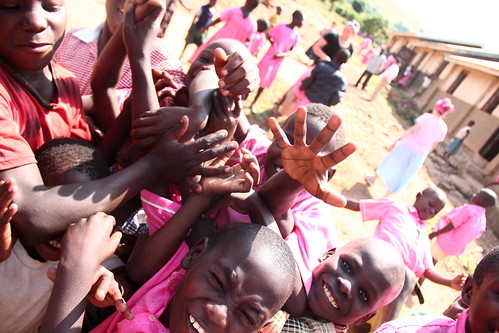
Not Forgotten: Journalism and Self Expression in Uganda, a photo by TheLouisianaJackhammer on Flickr.
1/400s at f/3.5 ISO 200
Thursday, September 8, 2011
The Dandelion's Mission and Studio Photography
Wednesday, September 7, 2011
The Dandelion's Mission and Studio Photography
A dandelion has the potential for exponential reproduction. However, as long as the seeds remain on the flower, its potential is never realized. When the wind blows, individual seeds are scattered wherever the wind takes them. The individual seeds then grow into dandelions and start the process all over again. One dandelion may produce dozens of new dandelions. In turn, each of the new dandelions produces dozens of dandelions.
In the same way, the church has the potential for rapid multiplication. As long as individual Christians are content to remain safe in their gatherings, the church’s potential will never be realized. But, when the Spirit of God blows freely over a church and individuals are sent out on mission, then one church can become many churches that start many more. This is what Kinesis wants to be about.
I decided to surprise him with a Kinesis original dandelion for his birthday. And this is what he got.
Tuesday, September 6, 2011
The Dandelion's Mission and Studio Photography
We faced a couple of problems. First, it was difficult to get the sharpness we wanted given the light we had available. More, and brighter, lights would have helped. Flash wasn't really an option since I was shooting at the highest frame-rate I could and would not be able to give the flash ample time to recharge. The image could probably be underexposed as well, there was so much darkness from the background, the light meter probably wanted to let in more light than was needed. Because of the need of a wide aperture to obtain a fast shutter speed and the close proximity of the subject, depth of field was affected—parts of the dandelion and seeds are not in focus.
Overall, it was a pretty good first attempt.
Monday, September 5, 2011
The Dandelin's Mission and Studio Photography
Thanks to Kara for the photos and being my assistant!
Blog Archive
-
▼
2011
(63)
-
▼
November
(14)
- Electroacoustic Interpretation of "Non-Commercial ...
- Warming The Seats
- End of the World: Track 1
- Remembering September 11
- Even Though...
- Macro Extension Tube
- Macro Extension Tube
- Stop Motion and Time Lapse: The Beginnings
- Downtown Springfield: A Time Lapse
- Downtown Springfield: A Time Lapse
- Star Trail 10/24/11
- Pleasant View Church: Part II
- Pleasant View Church
- Star Trail 7/26/11
-
►
October
(19)
- Star Trail 7/7/11
- Lightnin'
- Lightnin'
- Lightnin'
- Chocolate Chapstick (DS Remix)
- A Stranger No More To Be (DS Remix)
- Panoramic Narrative
- Panoramic Narrative
- Bottle Rocket Wars
- Bottle Rocket Wars
- Bottle Rocket Wars
- Bottle Rocket Wars
- Bottle Rocket Wars
- Dinner With A Gypsy: Ozark Empire Fair 2011
- Dinner With A Gypsy: Ozark Empire Fair 2011
- Dinner With A Gypsy: Ozark Empire Fair 2011
- Dinner With A Gypsy: Ozark Empire Fair 2011
- Dinner With A Gypsy: Ozark Empire Fair 2011
- Photo 1 Portfolio--Kara
-
►
September
(22)
- Photo 1 Portfolio--Kody
- Photo 1 Portfolio--Doren
- Photo 1 Portfolio--Kara
- Photo 1 Portfolio--Ty
- Big Rock Candy Mountain
- On a Walk Around the House
- On a Walk Around the House
- On a Walk Around the House
- On a Walk Around the House
- Not Forgotten: Journalism and Self Expression in U...
- Not Forgotten: Journalism and Self Expression in U...
- Not Forgotten: Journalism and Self Expression in U...
- Remembering September 11
- Not Forgotten: Journalism and Self Expression in U...
- Not Forgotten: Journalism and Self Expression in U...
- The Dandelion's Mission and Studio Photography
- The Dandelion's Mission and Studio Photography
- The Dandelion's Mission and Studio Photography
- The Dandelin's Mission and Studio Photography
-
▼
November
(14)

